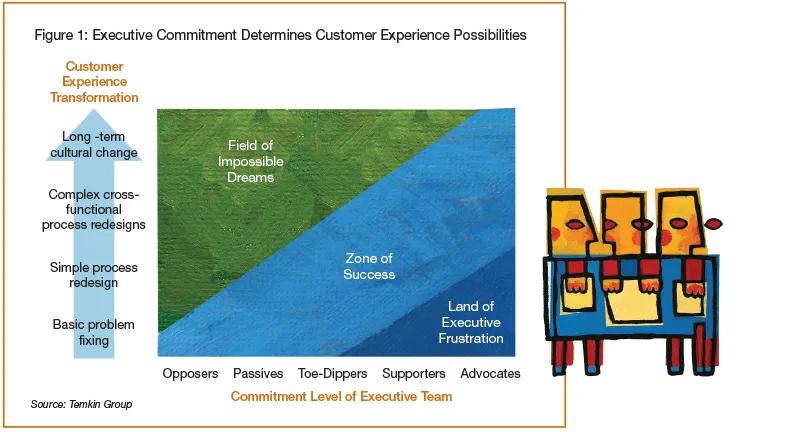I’m often asked the question: “What’s the ROI of customer experience?” To some degree, that’s a silly question. It’s like asking what’s the ROI of technology for Google, products for Best Buy, movies for NetFlix, or cars for Hertz.
Customer experience is an integral component of every organization that has customers. Think of it this way, what would happen to the financial health of your company if you just stopped interacting with your customers?
That doesn’t mean that the ROI question is a bad one. It just needs to be framed correctly. The question that should be asked is: “What’s the ROI of improving customer experience?” That’s not only a good question, but it’s an essential one for any company that is serious about customer experience.
Yes, everyone, customer experience improvements drive loyalty
At an aggregate level, my research while at Forrester Research showed that improvements in customer experience are highly correlated to higher loyalty in consumer markets. In a report called “Customer Experience Leaders Garner More Loyalty,” for instance, we found that companies considered customer experience leaders have more loyal customers than those that are customer experience laggards. The loyalty gap with consumers was 15 to 17 percent in three areas: willingness to buy more products, reluctance to switch, and likelihood to recommend.
Customer experience has a positive ROI as long as you don’t spend more than the value of the loyal customers you create. And since the value of adding 15 percent more loyal customers represents far more than what most companies spend on their customer experience efforts, there’s almost always a positive ROI.
Recognizing that customer experience improvements deliver positive ROI is not the end of the story. In some regards, it’s just a prerequisite for getting to some of the more practical issues in customer experience efforts. I’ll take a look at three key questions: Do all customer experience efforts have the same ROI? Who cares about ROI anyway? And, what impact does ROI have on the journey?
Do all customer experience efforts have the same ROI?
If all customer experience efforts had the same ROI then life would be easy—you could invest in any customer experience project that came your way. Clearly, there are enormous differences in ROI based on the size and value of the specific customer segment that you want to address with your efforts. I often hear the question: “What if we don’t have any clear customer segments?” If that’s the case, then don’t go ahead with the effort. Not only can’t you figure out the ROI, but you’re unlikely to satisfy the needs of customers if you don’t have a clear picture of who they are.
In addition to understanding the target customers, you need to look at ROI in terms of the type of value you are creating for customers. I always like to think of things in terms of the Kano Model, which identified five different types of value that customer perceive:
- Must-be value: Customers gets no value from some things you do unless your efforts meet a minimal threshold. Think of the value of an airplane ride if the pilots aren’t fully trained or a call center that doesn’t answer the phone in 10 rings.
- One-dimensional value: In some areas, the more you do of something, the more value clients get from it. Think of the value that customers get when a car salesperson adds additional years to a warranty or a busy apparel retailer adds new changing rooms.
- Attractive value: If the basics are in place, you can create enormous positive impact on customers with some unexpectedly nice touches. Think of the value that customers have when an electronics retailer throws in some required cables for free when the customer picks up her new monitor or when a hotel employee brings an unordered chicken soup to a guest who he knows is sick.
- Indifferent value: Some things that you do may have no perceived value, like lowering the price on a hotel room to a business traveler on an expense account.
- Reverse value: Some things that you do may have negative perceived value, like lowering the usability of your website after a redesign where you’ve added a lot of new features.
Using these Kano descriptors, you get the most ROI from customer experience efforts when you invest whatever is required in “must-be” items, fund a good mix of “one-dimensional” items, add a few “attractive” items in areas where you already have some consistency, and stay away from investing in anything that creates “indifferent or “reverse value”.
Who cares about ROI anyway?
Most executives care about the ROI of just about everything they invest their time and money on. But they are only partially satisfied with the results of generic, industry-level research findings. They want to know about the specific ROI for their customer experience efforts.
If customer executive leaders don’t address the ROI needs of key stakeholders, then they will find it difficult to gain the full commitment of those executives. To understand the interplay between ROI and commitment, here’s a very simple model outlining five levels of executive commitment:
- Opposers don’t believe in customer experience. These executives generally won’t support customer experience efforts no matter what ROI data they see, but can become passives when they see strong support from their peers.
- Passives don’t really care about customer experience. These executives may become toe-dippers if they see strong support from their peers.
- Toe-dippers are willing to offer some time and resources for customer experience. These executives will increase their participation and can even become supporters if they see strong ROI.
- Supporters are willing to give their resources to customer experience efforts and encourage their peers to do the same because they understand the ROI of these efforts. They use ROI results to strengthen their discussions across the company.
- Advocates fight any battle to make sure that customer experience efforts are funded. They generally understand the impact that customer experience has to the long-term competitiveness of the company without any project-based ROI data.
What impact does ROI have on the journey?
Hopefully, I’ve made the case that well-placed customer experience improvements drive loyalty and deliver a positive ROI, and that an understanding of this dynamic can increase executive commitment. All of this is just a preamble to what’s really important: how it affects your customer experience journey.
To look at this dynamic, I mapped the aggregate level of commitment of the executive team against the ambition of customer experience transformation efforts. This step identified three separate areas (see Figure 1).
The best place to be is in an area I call the “Zone of Success,” where the ambitions of the program are aligned with the level of commitment of the executive team. As long as customer experience programs stay in this range, they have a great opportunity to succeed.
In some cases the level of executive commitment can outstrip the pace of the customer experience program. This situation, called the “Land of Executive Frustration,” can be a problem for customer experience leaders. The executive team wants to recognize all of the great ROI faster than it can be achieved. In these cases it’s important to establish a multiyear roadmap that shows some incremental ROI results over time. It’s even possible to accelerate your efforts a bit to wind up in the “Zone of Success.”
Unfortunately, many efforts wind up in the “Field of Impossible Dreams.” In these situations, there’s not enough executive commitment to support the desired change. If you’re leading a customer experience effort that has ambitions in this area, then you need to raise the commitment level of the executives by using a solid ROI model—or go look for another job.

Tips for making the case with ROI
If you’re in a position where you have to make the case for customer experience based on business results and ROI, here are some recommendations to keep in mind.
- Enlist your CFO. You may have the brightest business analysts in the world on your team, but if the CFO’s team is not involved then they’ll always question your financial models and assumptions.
- Use existing metrics. Try to make your case based on the business metrics that the company already uses; it will make it easier for people to understand and will help you get their buy-in.
- Be conservative. Resist the temptation to use the high end of estimates for potential benefits. While the results may seem more compelling, they will also be harder to defend.
- Create a simple story. People tend to remember simple storylines, so make sure that you organize your results in a way that is easy for people to understand.
Closing thoughts on customer experience and ROI
I want to circle back around to the question that I posed in the title: What if customer experience has no ROI? If your customer experience improvements do not appear to have a positive ROI then you have three choices.
First of all, you can take a look at the model and assumptions that calculated the ROI and make sure you have fully captured the long-term benefits of increased customer loyalty. The next option is to refine your approach to customer experience—making sure you are investing in the areas with the highest business impact. Finally, if you still can’t see any ROI, then don’t invest in customer experience initiatives.
Customer experience is not an altruistic endeavor; executive teams should focus on it because they believe that it will help their organization’s long-term business results.















